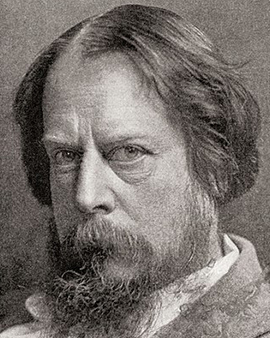


The talent was practically born to William Blake Richmond. His father George was already an important portrait painter and his grandfather Thomas had made a name for himself as a miniature painter in the English art scene. So it was almost inevitable that the young William Blake followed in these footsteps.
Born on 29 November 1842 in Marylebone in London's West End, the later graduate of the Royal Academy of Arts, named after the famous author and painter William Blake, a close friend of the family, was taught as a child mainly at home by private tutors. He also spent much time at the home of John Ruskin, one of the most important art critics of the Victorian era, where he received drawing lessons. He began studying the old masters at an early age. His educational journeys through Italy in 1859 and 1860 had a strong stylistic influence on him. Among his models were Tintoretto, Giotto and Michelangelo. He was also close to the Pre-Raphaelites, a group of artists founded in England in the middle of the 19th century who strove to reawaken nature in their works and were influenced by the painters of the Italian trecento and quattrocento, the Renaissance and the German Nazarenes. William Blake Richmond created his first painting in 1859, entitled "Enid and Geraint". He sold it for 20 pounds; he invested the money in his first trip to Italy.
In terms of painting, he was very versatile and cannot be pinned down to a specific genre. However, he showed a preference for women (especially for portraits) and for mythological themes. His most important works include "Hera in the House of Hephaistos", "Venus and Anchises" and "Electra at the tomb of Agamemnon". In addition to his work as a painter, William Blake Richmond also achieved great recognition as a sculptor and glass and mosaic designer. Characteristic of his entire oeuvre are bold colors and materials, which should make him one of the most relevant representatives of the Arts and Crafts Movement. Among his most famous works is the decoration in St. Paul's Cathedral in London. He later embarked on an academic career and became Slade Professor of Fine Art at Oxford University in 1878 for five years. At the Royal Academy he taught as professor of painting. He also excelled as an art writer and co-arranger of art exhibitions. In 1888 he was elected Associate of the Royal Academy, in 1897 he was ennobled as Knight Commander of the Bathorde. His most important title is perhaps that of an environmentalist. He was massively committed to improving the air in London, as he was horrified by the gloomy lighting conditions in the city in winter and the severe breathing difficulties caused by the high emission of coal dust and soot.

The talent was practically born to William Blake Richmond. His father George was already an important portrait painter and his grandfather Thomas had made a name for himself as a miniature painter in the English art scene. So it was almost inevitable that the young William Blake followed in these footsteps.
Born on 29 November 1842 in Marylebone in London's West End, the later graduate of the Royal Academy of Arts, named after the famous author and painter William Blake, a close friend of the family, was taught as a child mainly at home by private tutors. He also spent much time at the home of John Ruskin, one of the most important art critics of the Victorian era, where he received drawing lessons. He began studying the old masters at an early age. His educational journeys through Italy in 1859 and 1860 had a strong stylistic influence on him. Among his models were Tintoretto, Giotto and Michelangelo. He was also close to the Pre-Raphaelites, a group of artists founded in England in the middle of the 19th century who strove to reawaken nature in their works and were influenced by the painters of the Italian trecento and quattrocento, the Renaissance and the German Nazarenes. William Blake Richmond created his first painting in 1859, entitled "Enid and Geraint". He sold it for 20 pounds; he invested the money in his first trip to Italy.
In terms of painting, he was very versatile and cannot be pinned down to a specific genre. However, he showed a preference for women (especially for portraits) and for mythological themes. His most important works include "Hera in the House of Hephaistos", "Venus and Anchises" and "Electra at the tomb of Agamemnon". In addition to his work as a painter, William Blake Richmond also achieved great recognition as a sculptor and glass and mosaic designer. Characteristic of his entire oeuvre are bold colors and materials, which should make him one of the most relevant representatives of the Arts and Crafts Movement. Among his most famous works is the decoration in St. Paul's Cathedral in London. He later embarked on an academic career and became Slade Professor of Fine Art at Oxford University in 1878 for five years. At the Royal Academy he taught as professor of painting. He also excelled as an art writer and co-arranger of art exhibitions. In 1888 he was elected Associate of the Royal Academy, in 1897 he was ennobled as Knight Commander of the Bathorde. His most important title is perhaps that of an environmentalist. He was massively committed to improving the air in London, as he was horrified by the gloomy lighting conditions in the city in winter and the severe breathing difficulties caused by the high emission of coal dust and soot.
Page 1 / 1






